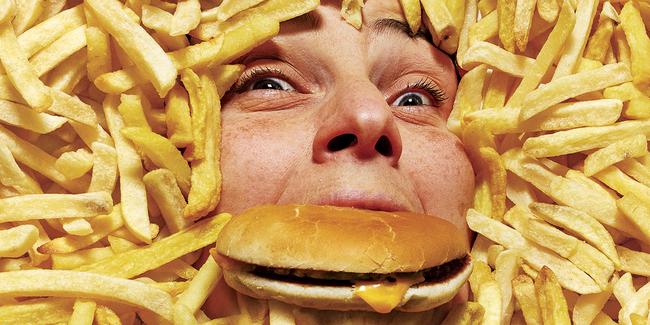Dalí-Freud, an obsession
A new exhibition in Vienna reviews Salvador Dalí's obsession for Freud's writings during his years of...
Leer másMarta Maria Fontina/Getty
A few years ago, Kevin Hall set out to deny a theory, backed by a growing number of nutritionists.According to this, people were increasing.Hall thought that the explanation had more to do with people simply consumed too many calories, fats and sugars.The idea that additional processing could be the cause of the problem, it just seemed "ridiculous".
Kevin Hall directs a research laboratory, which studies the regulation of metabolism and body weight, in theNational Institutes of Health of the United States (NIH).To demonstrate his theory he conducted a controlled experiment.In his opinion, he would exhibit, beyond any doubt, that the processing was not as important as the nutrients.
Recruited 20 volunteers and paid $ 5,000 to stay for a month in aNiH installation in Bethesda, Maryland.Divided volunteers into two groups.One of them mainly consumed healthy foods derived from simple ingredients with a minimum processing.For example, Greek yogurt, roasted steak and shrimp with spaghetti.The other group consumed Cereal HoneyNut Cheerios, Raviolles stuffed with chef Boyardee meat, Eggo pancakes and other processed foods.That is, the type of food consumed by most overweight people in the United States.Both groups were served an identical amount of calories and sugars and fats, but the volunteers were allowed to eat as much as they would like.
It turned out that Hall was wrong;In fact, the processing made all the difference.The subjects who fed on cheerios and chef Boyardee increased a little less than half a kilo per week on average.They also consumed an excess of 500 calories a day more than the other group.In addition, later, when they adopted a natural diet, they lost the extra weight they had gained.Conclusion: What the chemicals of food companies do to food, whatever that is, makes people increase.
Stimulated by these results, and by other later ones, the defenders of public health and the nutritionists have called on regulators.The objective is to establish similar measures to those used to stop the influence of tobacco companies in the 1990s.For example, limit the advertising of certain products aimed at children and actively discourage the consumption of key ingredients, mainly sugar.The global nutritional crisis is developed in forms that shivering the first days of tobacco consumption.(It is no coincidence that many of these companies subsequently acquired manufacturing companies of edible products).This time, it is the large grocery -manufacturing companies that promote harmful and possibly addictive products.
An issue in question is the explosive growth of the variety of products that are not simply processed in the conventional sense of the word.That is, not only to prolong their useful life, but are modified to maximize their flavor, visual attraction, texture, aroma and digestion speed.These products are made by decomposing natural foods in their chemical components.Then they are modified and recombined in new forms that maintain little similarity with anything that can be found in nature.These products are so radically altered that scientists have given it a new name: ultraprocessed.
Ultraprocessed products are generally designed to take advantage of human brain vulnerabilities.Particularly, the way the brain processes the sensations of pleasure.Generally, they send a signal to brain reward centers.And this is so fast and powerful that some neuroscientists think that it is as addictive as opioids or nicotine.
“We have become really good to strip, refine and process sugars and fats and turn them into these really powerful vehicles.In addition, its manufacture has become increasingly cheap, ”says Ashley Gearhardt, a professor of Psychology at Michigan University.
Gearhardt, who studies food addiction, adds: “Then, we combine them in totally novel edible products.These are much more rewarding than anything that our brain can handle in its current evolutionary state.That is why many of us cannot stop eating them ".
The implications for countries are worrying.Half adults suffer from diabetes or prediabetes.Three quarters of adults are overweight.Among children from two to five years, one in ten suffers from obesity.Among teenagers, this figure is one in five.
During Covid-19 pandemic, people with obesity were hospitalized three times greater than those who do not suffer from this disease.If combined with other health -related health problems, such as cardiovascular disease and diabetes, obesity increases the risk of hospitalization, and 12 times the risk of death.
In other words, our food is killing us.Edible products manufacturing companies have fooled our brain so that we become complicit.And our elected officials and rulers are also.It is necessary to understand exactly how processed products ill.And also publicly calculate what the function of large grocery -manufacturing companies in the current health crisis has been.Until now, people in charge of generating policies have shown little interest in analyzing the tactics of the powerful lobbyists of edible products.However, government officials face a growing pressure to reduce the consumption of ultraprocess products.
"Now we have accumulated evidence, particularly in the last five years, which shows that people who consume more ultraprocessed products have a greater risk of obesity, diabetes, cardiovascular diseases, depression, cancer and kidney and liver diseases," says MarionNestle,Emerita Professor ofNutrition, Food Studies and Public Health at the University ofNew York."The studies have been overwhelming.There have been hundreds and hundreds of them.Without a doubt, it's not a good thing.It's a problem ".
Human beings have modified food since the hunters discovered the fire and found out how to roast animals in the stone age.10,000 years ago, the former inhabitants of Mesopotamia and Egypt learned to smoking, salt and drying food to conserve them.In the nineteenth century, pasteurization and canned techniques largely expanded food storage and transport capacity.
Processed foods, as we know today, emerged in the first half of the twentieth century.At that time, food engineers found out how to use modified potato starch to transform pork, ham, sugar, water and sodium nitrate into a gelatinous and malleable dough that coupled in a rectangular can labeled with the word "spam".The growing demand for fast food with a long shelf life financed the necessary scientific studies.The result was the spray drying process, evaporation, freezing drying.And also a sophisticated process to make a decent cake that could be placed on the shelves and be consumed two years later.

At the beginning of the 2000s, the population obtained more than half of its calories from chicken nuggets, artificially sweetened canned food, fried potatoes and other connovages of human creation.
Nutritionists did not create a language to describe this trend until 2009.That year, Carlos A.Monteiro, Professor ofNutrition at the University of Sao Paulo, presented the “Nova Food Classification System”.This was a novel classification that is not based on nutritional content, but on the magnitude and purpose of the physical, biological and chemical processes to which food is submitted after being separated from nature.
Monteiro coined the term "ultraprocess" (in opposition to "minimally processed" or simply "processed") to refer to "industrial formulations made completely or mainly from substances extracted from food (oils, fats, sugars, starch and proteins), derived fromFood components (hydrogenated fats and modified starches) or synthesized in the laboratory from food substrates or other organic sources (such as flavor enhancers, dyes and edible additives used to make the product hyperapetectible).Monteiro excluded food exposed to simple processes such as drying, fermentation and pasteurization that could subtract part of the food (frozen vegetables, dry pasta or eggs).
It also excluded products that contain salt, sugar, oil or other substance added to natural or minimally processed foods and that could still be recognized as versions of the original foods (such as beef cecina or freshly baked bread).
In contrast, the category of ultraprocessed products was designed to include creations worthy of the DR.Frankenstein.These are made with added sugar, salt, fat and starches extracted from naturally produced foods.Then, they are mixed with dyes, flavorings and artificial stabilizers that serve as binders.Soft drinks, cold meats, industrialized cookies and salty snacks such as pretzels enter this category, like many frozen and canned products.
"They are not food," says Monteiro.“They are formulas.They contain chemical compounds that do not belong to food or, rather, that they should not belong to food ”.
Many researchers dismiss the Monteiro classification system for considering it extremely broad.After all, the category of "processed foods" covers a wide variety of different products with infinite nutritional profiles.It includes Twinkies, Doritos and Diet Soft drinks.Also, high protein saucers such as chicken fajitas of the Lost brand, which are made with true chicken breast.But it is combined with dextrose, sugar, guar rubber, yellow cornmeal and other ingredients.And the meat with chili and hormel beans, made with true beef, beans and ground tomatoes, combined with less than 2 percent of modified corn starch, soy flour and caramel color.
However, by defining a new category at processing levels, Monteiro gave public health experts and epidemiologists the language to talk about how industrial chemists have changed food.And how to relate their inventions with a wide variety of health problems.The strength of these associations soon began to generate attention.
Scientists have not found out how processed foods make people increase.Nor which of the thousands of chemicals, additives and nutrients really produce a worsening in health results.But market forces that have guided edible products are clear enough.Between 1980 and 2000, the period in which obesity and metabolic diseases began to shoot, the number of calories available for purchase in food supply increased 20 percent.That significantly increased competition due to limited attention and stomach capacity of consumers.
Nestle, author of many books on government aspects of food policies, indicates that federal agricultural subsidies that guaranteed surplus in crops such as corn, reached the market along with the generalized adoption of cheap additives in the 1970s, such as syrupof high fructose corn, and that these were some of the factors that promoted this overproduction.Meanwhile, in the 1980s, shareholders increased pressure to grocery -producing companies to increase their quarterly profits to maintain upward shares prices.All this fed a high -risk arms race in the food industry between rival products and marketing teams.
"If a person tries to sell their edible products and obtain a gain in an environment in which there is twice the calories that anyone needs," saysNestle, "that person will have to get consumers to buy their product instead of the of other.Or make everyone eat more in general ".
To sell more, groceries manufacturing companies made their products everywhere.They were sold in bookstores and libraries.They settled in clothing stores, pharmacies and gas stations.They offered larger portions and created more cartoon characters to sell cereals.They also summoned scientists who contributed to develop ingenious marketing techniques and scientific innovations to sell more food.
Michael Moss dedicates a whole chapter of his book Salt Sugar Fat (Addicted to junk food) to the feats of Howard Moskowitz.This is a star of the industry that was a pioneer in the use of advanced mathematics and computational science to "optimize" edible products so that they produce the most intense cravings.Over the years, Moskowitz made the reengineering of a wide variety of products that went from the General Mills cereals to the Salsa for Spaghetti of Prengo.He tested different modifications in color, aroma, packaging, flavor and texture with human Indies bunches.And introduced the data into a sophisticated mathematical model that "compares the ingredients with the sensory perceptions they generate".So “I can simply‘ upload the volume ’to the product,” Moskowitz explained to Moss.
The most important weapon of the arsenal of the large grocery producing companies is sugar.Moskowitz coined the term "said point" to describe "the perfect amount" of sweetness in a product to maximize its consumption.By focusing on the spotlight, Moss says, groceries manufacturing companies changed the palate in forms that predispose us to eat the bad (fries and ice cream) and leave aside the good (broccoli and asparagus).States that, in recent studies, it is shown that 66 percent of the groceries that are currently sold in stores contain added sweeteners.
"These companies have learned to find and take advantage of our basic instincts that makes food attractive," says Moss.In whose most recent book, Hooked (hooked), examines the addictive capacity of food.“The problem is not that these companies have found the perfect amount of sweetness for things such as soft drinks, cookies or ice cream.The problem is that they have added sugar to things that did not usually be sweet, such as bread, yogurts and spaghetti sauce.This has generated the expectation that everything must be sweet ”.
The fructose, which is one of the most commonly used sweeteners, is now present in many foods in concentrations that do not exist in nature, according to Robert Lustig, a pediatric endocrinologist affiliated with the University of California and author of Metabolical (metabolic).In recent years, various studies have shown that fructose destroys or inactive several key enzymes necessary for the healthy functioning of mitochondria.These are the energy generators of human cells, which convert simple sugars into ATP, the form of energy that human body and brain use to carry out their functions.
This disturbance in the conversion of energy produces an accumulation of unprocessed glucose that circulates in the bloodstream.When it perceives excess glucose, the pancreas floods the system with the insulin hormone, which orders the body to remove the glucose from the blood torrent and the fatty -shaped warehouse.Part of this fat tends to accumulate in the liver, on which our body depends to filter, process and balance the blood.The sick liver and the problem worsens.Seeing us deprived of energy that our mitochondria would normally produce, we are forced to eat more.
"It should not surprise that children now suffer from type 2 diabetes and fatty liver, which used to be diseases produced by alcohol," he says."Now we know that fructose is a mitochondrial toxin, which becomes fat in the liver and is metabolized by this in virtually identical ways to the way alcohol is metabolized.".
Sugar is not the worst problem in food.The consumption of processed grains that are used in the production of corn flakes, white bread and many other products is even more harmful.These grains are stripped of their outer cascarilla, known as "bran", and the inner germ, which contains fiber, fatty acids and nutrients, leaving only carbohydrates.The human body digests these freed carbohydrates much faster than when they are locked in the grains.
“Instead of settling in the stomach and gradually decomposing in glucose, they begin to break down as soon as they reach their mouths, and by the time they reach the stomach they are already practically digested.When they arrive at the small intestine they have already been totally absorbed, ”says Dr.Dariush Mozafarian, cardiologist and dean of the Department ofNutrition of the University of Tufts.
This rapid digestion deprives of food to intestinal bacteria, which we depend so that our digestive system works in a healthy way.That produces greater intestinal permeability that, in turn, can allow bacteria and toxins to enter the bloodstream and cause generalized inflammation, an important factor in a wide variety of disorders, such as celiac disease, diabetes, asthma, Alzheimer's disease and cancer.
This also floods to the bloodstream and causes insulin concentrations to increase pronounced.This high "glycemic load", which indicates the speed with which the concentration of blood sugar increases, can have long -term consequences in the way our body processes food.You can also generate long -term deregulation of hormonal systems.These hormones order the body that stores more fat instead of providing calories to keep the body in operation.The body, deprived of energy, craves food, which means that we are permanently hungry, even when we have eaten in excess.
"After having attended thousands of patients with obesity, I think that people can show great discipline in relation to the choice and selection of their foods if they experience benefits," says David Ludwig, pediatric endocrinologist at the Boston Pediatric Hospital and Pediatrics Professor and Pediatrics Professorof the Harvard andNutrition Faculty of Medicine at Harvard's Faculty of Public Health."I think we have problems constantly resisting extreme hunger".
Some researchers indicate that change in our diet could also have caused a change in our brain.This could have been reconfigured with aberrant patterns that lead us to eat compulsively.And, possibly, even addiction.
Nora Volkow, neuroscientific and director of theNational Institute on Drug Abuse (NIDA) ofNIH, was one of the first people to investigate food addiction, in the 1980s.It was surprised by the similarities between compulsive behaviors and experiences related by addicts to drugs and alcoholics and those related by obese patients who claimed to be unable to control their way of eating.In recent years, he affirms, evidence of his laboratory and others in which the patterns of pathological cerebral activation that are observed in people addicted to drugs that are observed in many people with morbid obesity and compulsive dining rooms have emergedwho participated in different investigations.
"When I began to speak for the first time about it there was a total and absolute rejection, and almost angry, by the people who insisted that it was an endocrinological disease and not an addictive disease," he says."But it is an artificial distinction.If we look at it from the outside, what is the difference between nicotine and processed groceries if both have been optimally designed to generate that compulsive response, an answer that manipulates the dopaminergic system in a way that does not occur with natural foods?"
At the beginning of the 2000s,Nicole Avena began studying whether or not the scientific criteria of other addictive substances after hearing that several addicted people claimed that it was more difficult for them to leave sugar than heroine.Avena, an attached professor of neurosciences of the Mount Sinai Faculty of Medicine, discovered that sugar, both in animals and in humans, produced binge.All of which are components of the addiction that is usually seen with the substances of illicit use.
He also observed neurochemical and neuroimaging changes in the brain, which were identical to those observed in people addicted to drugs.If it was combined with other ingredients present in ultraprocess groceries, sugar was even more addictive.In rats it was discovered that sugar was as addictive as cocaine.
"Our brains are simply not designed to process the different types of ingredients in the amounts to which we have been exposed," says Avena.
Ultra -processed groceries have something else in common with nicotine: from the 1980s to the end of the 2000s, some of the largest prosecuted grocery producers were known as the large tobacco companies.In 1985, RJ Reynolds acquiredNabisco for 4.900 million dollars.And Phillip Morris acquired General Foods in an agreement for 5,750 million dollars.This was, at the time, the greatest acquisition in the history of the United States outside the oil industry.Phillip Morris added Kraft to his business portfolio in 1988 and renamed altria in 2003.
One of the most important factors to produce an addiction is the speed with which a drug enters the body and activates the brain reward centers.At the time when large tobacco companies began to acquire food companies already had decades of experience in the study and optimization of the speed with which their products took the nicotine to the brain.They continued taking advantage of those scientific discoveries in their edible products.
"Many of those ultraprocessed groceries have been practically pre -sticated for us," he says."They melt immediately in the mouth.There is no protein, no amount of water, no fiber that reduces its speed.They arrive at the taste papillae and immediately activate the reward and motivation centers of the brain.Then, a secondary dopamine blow occurs when they are absorbed in the body ".
To change people's way of thinking, scientists will need to better understand what are the elements that feed this public health crisis.
What is in the ultraprocessed groceries that encourage consumption abuse and weight gain?This question is the subject of intense speculations and debates in the world of nutritional science."We need a monumental effort related to nutrition," says Tufts Mozafarian."We are drowning in the midst of an epidemic of food -related diseases".
Kevin Hall, meanwhile, continues with his research on healthy food consumers compared to those who consume processed foods.“We need to better understand what are the mechanisms that drive the harmful effects of food.The objective is that we can direct policies and possible reformulations to improve health ”.
Among other projects, he plans to direct another comparative study to ensure that people do not eat more simply because food knows better.This time it will ensure that the processed and unprocessed dishes have an equally delicious flavor, according to the criterion of independent cuisine.It is expected that the results will bring us a little more to knowledge and, finally, to action. N
(Publicado en cooperación conNewsweek / Published in cooperation withNewsweek)
Do you want to receive real -time notifications about new content of this type?
A new exhibition in Vienna reviews Salvador Dalí's obsession for Freud's writings during his years of...
Leer másThe World Health Organization ensures that more research on the Umicron Ba subvariant is necessary.2.And warn...
Leer másSince the omicron was declared a variant of concern, on November 26, 2021, a large number of...
Leer másThe United States presidential couple finally fulfilled one of their promises: installing a feline in the White House.HE...
Leer másThe population of Russia registered a setback of more than one million inhabitants in 2021, a record from the...
Leer másThe second year of Joe Biden's mandate represents great challenges on the global agenda and consequently for Mexico.We witness...
Leer másThe dragon protector is a book for children and adults whose objective is to address the sexual rights of childhoods...
Leer másWhen I was 19, a car hit me and I had to keep bed.I depressed and stopped eating, but...
Leer más

This Friday we have information about the Mexican champions in Mathematics, Roberto Palazuelos' clothing brand, Celta's new soccer schools and more.Mexico wins 6 medals at the Olim...

Exclusive ContentThe article you are trying to access is exclusively for subscribersSubscribe Find out about our plans and enjoy El País without limits.Enter If you are already a subscriber you can enter with...

Adjusting the bicycle derailleur can be something very simple if we know what we are doing, or it can become a real headache for not knowing how to find the key or, why not, because...
'The ambassador's daughter': everything about the premiere of the Nova series
18/03/2022A girl named Melek arrives in her living room and finds a dead man. Her mother, in the bathroom, cleans the blood from her clothes and her face, in addition, she keeps a knife along with the rest of the things in ...